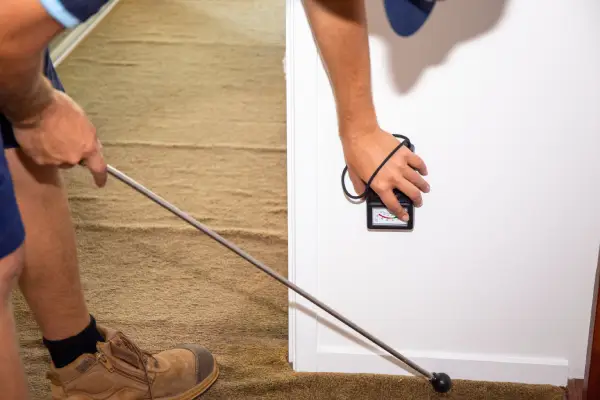What to Expect During a Termite Inspection

Termites can do serious structural damage long before you ever notice the first telltale clue. Because they hollow wood from the inside out, the earliest signs are easy to miss — until a baseboard crumbles or a door suddenly won’t close. That’s why an annual inspection from a licensed professional is so important, especially in termite-prone South Florida.
Think of it as routine maintenance for your biggest investment. A trained eye can catch hidden activity early and lay out an action plan before costly repairs are on the table. A great way to avoid major repairs and save money over the long run, here’s what to expect during a termite inspection.
What Do We Look for During a Professional Termite Inspection?
Booking an annual inspection with a licensed termite specialist is like taking your car to a trusted mechanic: we know the hiding places, the early warning signs, and — if trouble appears — the best fix. In termite-prone South Florida, that professional once-a-year “oil change” for your home is priceless peace of mind.
Termites telegraph their presence in several subtle ways. In addition to mud tubes, discarded wings, and hollow-sounding or blistered wood, we look for piles of frass (termite droppings), paint that suddenly bubbles or peels, floors that sag or feel spongy, tight-fitting doors or windows caused by warping, and even faint clicking sounds inside walls.
By tracking these clues, we can pinpoint both active colonies and conditions that attract them. Our inspection leaves no hiding place unchecked, including:
- Exterior perimeter
- Foundation and slab edges
- Interior trim
- Attic
- Crawl space or sub-floor
- Garage and outbuildings
- Landscape risk zones
Our Termite Inspection Process
Inspecting for termites isn’t a quick stroll around the yard. It’s a systematic, start-to-finish evaluation that uncovers hidden activity, structural weak points, and future risk factors. Our inspectors follow a proven workflow that has protected thousands of South Florida homes from costly damage. Here’s how we do it, step by step:
- Exterior Inspection: We circle the home, scanning siding seams, eaves, and soil lines for mud tubes, blistered paint, or soft spots.
- Foundation Check: Foundations get extra scrutiny. Cracks, foam board insulation, and plumbing entries are probed for hidden galleries.
- Interior Inspection: Inside, we examine baseboards, window sills, and door casings, tapping for hollows and looking for faint pinholes.
- Attic and Crawl Space Examination: These overlooked spaces are termite heaven. We crawl, climb, and light up every beam to catch activity early.
- Moisture Detection: Using state-of-the-art moisture meters, we pinpoint damp zones — termites’ favorite hangouts — behind walls or under floors.
- Wood Testing: A blunt probe or screwdriver checks suspect wood; a sharp “give” signals internal tunneling.
- Yard Inspection: Logs stacked against the house, buried roots, or even a decorative trellis can be termite on-ramps. We note them all.
- Documentation and Reporting: Findings, photos, and risk ratings are compiled into a clear report. You’ll know what we saw, where we saw it, and what it means.
Start With A Quote On Us
Click below to contact Petri Pest Control for a FREE pest control quote.
How to Prepare for a Termite Inspection
A few minutes of prep saves time and ensures we can inspect every inch thoroughly. Help us help you by following these easy steps:
- Clear storage boxes, furniture, or decor away from baseboards and garage walls.
- Unlock gates, crawl-space doors, and attic accesses.
- Trim back shrubs or vines touching exterior walls.
- Remove stored items from under sinks so plumbing areas are visible.
- Tell us about prior termite treatments or any recent wood repairs.
What Happens After Your Termite Inspection?
After your termite inspection, our expert will present their findings and make recommendations on where to go from there.
Outcome 1: Termites Detected
Your inspector reviews the evidence, explains species and severity, and outlines treatment choices—liquid barriers, baiting systems, or a hybrid approach—along with timelines and warranties.
Outcome 2: All Clear
Great news! But vigilance wins the long game. Keep termites out with these easy habits:
- Reduce moisture: fix leaks, maintain gutters, redirect AC condensate.
- Store firewood high and dry: at least 18″ off the ground and 20′ from the house.
- Maintain a clear perimeter: no soil-to-wood contact on siding or decks.
- Schedule annual checkups: catch any new activity before it escalates.
Schedule a Termite Inspection in Pompano Beach Today
Termites don’t rest — and neither will we. Our certified termite control experts combine local know-how with state-of-the-art tools to spot problems early, treat them decisively, and back the work with rock-solid guarantees.
Whether you’re safeguarding your home or business, call us today to get started.
Back to Termite TreatmentWhat to Expect During a Termite Inspection in Pompano Beach
Pest Control in Pompano Beach
